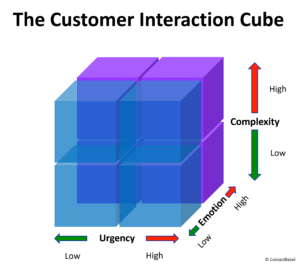Introducing the Customer Interaction Cube, and the eight types of contact centre interaction
Whatever the specific vertical market a given organisation’s contact or call centre operates in, there are two main influences that will need to guide its decisions: the commercial activity within that sector, and the preferences and requirements that customers have in relation to contacting the organisation.
Yes, the nature of the given business vertical market does need to be taken into account; however, it is also crucial to consider how urgent, complex, and emotionally important each particular interaction is.
When customers call a bank’s call centre, for example, the person who simply wishes to check their bank balance will likely have very different preferences and needs to the person who is urgently calling to check how their mortgage application is progressing.
What is the Customer Interaction Cube, and why is it needed?
With there being various types of customer interaction that organisations need to handle, a structure known as the Customer Interaction Cube has been developed. This structure provides a means of categorising contact centre interactions on the basis of their urgency, complexity and emotional input as far as the customer is concerned.
The existence of the Customer Interaction Cube, accounting for high and low levels of interaction urgency, complexity, and emotional input alike, enables organisations to be more informed in their decision-making.
They can use it to, for example, analyse the volumes they receive of each type of customer interaction, cross-referencing it with other variables such as the times of day they receive certain types of interactions, and customer demographic preferences. This process, in turn, can help ensure the appropriate levels of resourcing are allocated to different channels, in order to improve the customer experience and lower the cost of service.
The eight types of interaction that make up the Customer Interaction Cube
The Customer Interaction Cube takes the form of a 2x2x2 structure, effectively covering eight types of interaction through the various combinations of high and low urgency, complexity, and emotional input.

Distinguishing between these different types of interaction is important, given that different interaction types may be best suited to different channels. So, there could be benefits for both the organisation and the customer in ensuring certain interaction types are matched to a suitable channel.
But what are those eight interaction types, what would be good examples of each given interaction type, and what channels might be best suited to handling the given type of interaction? Below is a summary.
- Low emotional importance, low urgency, low complexity
If a customer is carrying out casual research into a product or simply wishing to give a meter reading, such interactions could be considered ‘low’ in relation to all three of the above parameters. Self-service might therefore serve as an ideal primary channel for such interactions, followed by web chat.
- Low emotional importance, low urgency, high complexity
Good examples of this type of interaction include finding out about proposed planning or house building, and seeking out instructions on how to program a TV remote. Email could be an effective primary channel for this interaction type, with phone as a secondary channel. Customers may well want to visit a physical store or branch as well.
- Low emotional importance, high urgency, low complexity
If a customer needs to top up their mobile credit or check that a payment has been made, this type of interaction might be most suitable for self-service, with phone or web chat contact as a secondary channel.
- Low emotional importance, high urgency, high complexity
A customer interaction may have this combination of characteristics when they are seeking out details of how to make an insurance claim, or trying to understand mobile roaming charges ahead of their imminent trip to another country. Web chat or self-service tends to work well for this type of interaction, with a possible secondary channel being phone contact.
- High emotional importance, low urgency, low complexity
A customer attempting to book train tickets for an important engagement would be one example of this interaction type and might be best served via self-service, although phone could still be an important supporting channel.
- High emotional importance, low urgency, high complexity
If a customer has a complaint about incorrect billing, phone contact with the call centre might be a suitable first step, with email a secondary channel.
- High emotional importance, high urgency, low complexity
A simple question about an imminent desired purchase – such as when they can expect their ordered item to be delivered – would be a good example of this type of interaction from a customer. Web chat could represent a good primary channel for such an interaction, and phone or social media a secondary one.
- High emotional importance, high urgency, high complexity
An obvious example of this type of interaction would be a household emergency necessitating a call to 999, with phone contact being the primary channel, and web chat a possible secondary channel.
One more thing…
As we touched on above, the task of deciding how different types of customer interaction can be most suitably handled is more complicated than simply understanding – and responding to – these eight types.
Other variables, such as demographics, time of day, and whether certain channels are more easily accessible to some customers than they are to others, will impact on the decisions your organisation needs to make about the suitability of channels.
To learn more about this and many other aspects of how your organisation can refine and improve the call centre experience, please feel free to download our “2022-23 UK Customer Experience Decision-Makers’ Guide”, or the equivalent US version, from the ContactBabel website.

